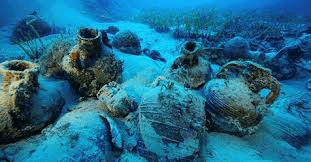Underwater Archaeology and the Secrets of Maritime History
Underwater archaeology is a fascinating field that holds the key to unlocking the mysteries of our maritime history. It involves the study and exploration of submerged sites, shipwrecks, and artifacts to gain valuable insights into past civilizations and their interactions with the sea. Maritime history, on the other hand, is the study of human activity at sea and its impact on society, culture, and global trade. These two disciplines are intertwined, as understanding maritime history often requires the meticulous work of underwater archaeologists. In this blog post, we will explore the importance of underwater archaeology and how it plays a crucial role in uncovering the hidden secrets of maritime history.
Table of Contents
The Techniques and Tools of Underwater Archaeology
In the field of underwater archaeology, various techniques are employed to uncover the hidden secrets of maritime history. Remote sensing and sonar technology are two prominent techniques utilized by underwater archaeologists. Remote sensing involves the use of advanced equipment to survey large areas underwater and gather data about potential archaeological sites. This technique allows archaeologists to detect anomalies in the seabed, such as shipwrecks, ancient settlements, or submerged artifacts.
Another vital tool used in underwater archaeology is submersibles. These specially designed vessels enable archaeologists to dive to great depths and explore submerged sites with precision. Submersibles provide researchers with the opportunity to study underwater environments firsthand, collect samples, and document findings extensively.
Additionally, Remotely Operated Vehicles (ROVs) play a crucial role in underwater archaeological research. These unmanned robotic devices are equipped with cameras and sensors, allowing archaeologists to explore deep-sea sites more efficiently. ROVs also assist in delicate excavation work and artifact recovery, as they can reach areas that are challenging or dangerous for human divers to access.
Furthermore, remotely operated grab samplers are utilized for collecting sediment samples and artifacts. These tools enable archaeologists to carefully retrieve artifacts without causing damage to their fragile state. They can access the seabed and retrieve samples for further analysis, providing valuable insights into past maritime cultures and civilizations.
Underwater archaeologists face numerous challenges in their work, including limited visibility, strong currents, and the corrosive effects of seawater on artifacts. However, they have developed innovative solutions to overcome these obstacles. For instance, photogrammetry is used to create accurate three-dimensional reconstructions of submerged sites, helping researchers obtain a comprehensive understanding of the artifacts and their surrounding environment.
In conclusion, underwater archaeology relies on a combination of techniques and tools to unveil the secrets of maritime history. From remote sensing to submersibles, these methods aid in the discovery and preservation of submerged artifacts and shipwrecks. Despite the challenges presented by the underwater environment, underwater archaeologists remain dedicated to unraveling the mysteries of our marine past and ensuring the protection of these valuable historical resources.
Discoveries in Underwater Archaeology
Underwater archaeology has led to numerous remarkable discoveries worldwide, unveiling the hidden treasures of our maritime past. Through meticulous excavation and exploration, underwater archaeologists have unearthed a wealth of notable discoveries that provide invaluable insights into our history.
One such discovery is the Aeolos shipwreck, located off the coast of Greece. This ancient shipwreck from the 5th century BC revealed an impressive collection of objects, including pottery, jewelry, and even well-preserved wooden hull fragments. These artifacts shed light on ancient trade networks, craftsmanship techniques, and daily life in that era.
Another significant shipwreck is the Vasa, a 17th-century warship that sank on its maiden voyage in Stockholm, Sweden. The excavation of the Vasa site unveiled an astonishingly well-preserved vessel, offering a unique glimpse into the naval technology of the time. This discovery revolutionized our understanding of shipbuilding techniques and maritime warfare during the era of the Swedish Empire.
Preserving artifacts found underwater is a crucial aspect of underwater archaeological work. The marine environment poses numerous challenges to preservation, such as exposure to corrosive saltwater and the risk of looting. Underwater archaeologists employ various techniques to ensure the long-term conservation of these treasures. Methods such as desalination, stabilization, and meticulous documentation are employed to safeguard these artifacts for future generations.
By studying these discoveries, underwater archaeologists not only contribute to our knowledge of maritime history, but they also provide a glimpse into ancient civilizations, trade routes, and cultural exchanges. Through the analysis of shipwrecks, we can uncover fascinating details about the lives of past societies and their interactions with the sea. These insights help piece together the puzzle of maritime history, allowing us to better understand our collective heritage.
The field of underwater archaeology continues to evolve, with advancements in technology revolutionizing the way discoveries are made. Modern tools such as side-scan sonar and remotely operated vehicles have greatly facilitated the identification and exploration of underwater sites. These technologies enable researchers to conduct thorough surveys and gather important data without physically disturbing the delicate marine environment.
The future of underwater archaeology holds great promise for further discoveries. As technology improves, we can expect even more significant findings that will reshape our understanding of maritime history. However, to realize this potential, it is essential to continue supporting and appreciating the work of underwater archaeologists. They are the custodians of our marine past, tirelessly unraveling the mysteries hidden beneath the waves. Only through their dedication and ongoing research can we ensure the preservation and the legacy of our maritime history for generations to come.
In conclusion, underwater archaeology has provided us with a plethora of exciting discoveries that uncover the secrets of our maritime past. These notable findings, including the Aeolos shipwreck and the Vasa warship, have offered valuable insights into ancient civilizations and maritime technology. The preservation of artifacts found underwater is crucial, and the work of underwater archaeologists ensures that these treasures are safeguarded for future generations. Through their endeavors, we can gain a deeper understanding of our maritime heritage and continue to explore the mysteries hidden beneath the waves.
Insights Gained from Underwater Archaeology
Underwater archaeology is a fascinating field that plays a crucial role in enhancing our understanding of maritime history. Through the analysis of shipwrecks and the artifacts found underwater, researchers gain valuable insights into past civilizations, trade routes, and cultural exchanges.
By exploring shipwrecks, archaeologists are able to uncover a wealth of information about the people who sailed the seas centuries ago. Underwater archaeology sheds light on the lifestyles, technologies, and customs of these past societies. For instance, the discovery of an ancient shipwreck filled with pottery and artifacts can provide valuable clues about the trading practices and cultural exchanges of the time.
Furthermore, the study of shipwrecks allows us to trace historical trade routes and understand the dynamics of global commerce in different eras. By analyzing the cargoes and cargoes of sunken ships, archaeologists can piece together the puzzle of maritime history. This knowledge not only helps us understand the economic development of various regions but also reveals the interconnectedness of ancient civilizations.
The importance of underwater archaeology is further highlighted by the preservation of artifacts found underwater. Due to the lack of oxygen and light, many artifacts that would have decayed on land are remarkably well-preserved in underwater environments. These artifacts offer unique glimpses into the past, providing tangible evidence of historical events and societal practices.
In conclusion, underwater archaeology is a vital tool for unraveling the secrets of maritime history. Through the exploration of shipwrecks and the analysis of artifacts, researchers gain insights into past civilizations, trade routes, and cultural exchanges. By piecing together this information, we can reconstruct the puzzle of maritime history and gain a deeper appreciation of our marine past. It is imperative that we continue to support and appreciate the work of underwater archaeologists, as they play a crucial role in preserving our maritime heritage for future generations.
The Future of Underwater Archaeology
With advancements in technology, the field of underwater archaeology is experiencing a revolution. New techniques and tools are being developed and are enabling archaeologists to uncover even more secrets of maritime history.
One of the most significant advancements is remote sensing. This technology allows archaeologists to survey large areas underwater without physical intervention. Using sonar technology, researchers can create detailed maps of the ocean floor, identifying potential sites for further investigation. This has greatly expedited the process of underwater archaeological exploration.
Moreover, specialized tools such as submersibles, ROVs (Remotely Operated Vehicles), and remotely operated grab samplers have become essential in underwater excavations. These tools allow archaeologists to explore and retrieve artifacts from great depths and in challenging conditions. They provide an opportunity to obtain valuable information about past civilizations and their interactions.
The potential for future discoveries in underwater archaeology is immense. Many areas of the world’s oceans remain unexplored, holding the untold stories of ships and civilizations lost to time. As technology continues to advance, the scope for uncovering these hidden treasures expands.
Uncovering these treasures has a profound impact on our understanding of maritime history. Through the analysis of shipwrecks, archaeologists gain insights into past civilizations, trade routes, and cultural exchanges. The artifacts found underwater serve as tangible reminders of our maritime past and provide clues to how human societies have evolved over time.
To continue unraveling the mysteries of maritime history, continued research and preservation efforts are crucial. The underwater environment is uniquely challenging, with factors such as saltwater corrosion and delicate ecosystems affecting the preservation of underwater sites and artifacts. By supporting and appreciating the work of underwater archaeologists, we ensure the preservation of these invaluable historical records for future generations to study and learn from.
In conclusion, the future of underwater archaeology is bright. Advances in technology have revolutionized the field, providing new opportunities to explore and uncover hidden secrets. The potential for future discoveries is vast, and with continued research and preservation efforts, we can piece together the puzzle of maritime history, illuminating the stories of the past for generations to come.
Conclusion
In conclusion, underwater archaeology plays a crucial role in uncovering the secrets of maritime history. Through the use of various techniques and tools, such as remote sensing and sonar technology, underwater archaeologists are able to explore the depths of the ocean and discover significant shipwrecks and artifacts that hold historical significance.
Not only does underwater archaeology enhance our understanding of maritime history, but it also provides insights into past civilizations, trade routes, and cultural exchanges. By analyzing shipwrecks, we can piece together the puzzle of our marine past and gain a deeper appreciation for the way different societies interacted with each other.
The future of underwater archaeology looks promising, thanks to advancements in technology that are revolutionizing the field. With new tools and methods being developed, there is great potential for future discoveries that will further unravel the mysteries of maritime history. However, it is crucial that we continue to support and appreciate the work of underwater archaeologists, as well as prioritize the preservation of underwater sites and artifacts for future generations.
In conclusion, underwater archaeology not only allows us to uncover hidden secrets but also provides a glimpse into the rich and diverse history of maritime civilizations. It is through the combined efforts of researchers and the support of society that we can continue to unravel the mysteries of our marine past and preserve these valuable historical artifacts for generations to come. Let us value and appreciate the work of underwater archaeologists, as they continue to delve into the depths and bring the secrets of our maritime history to the surface.







